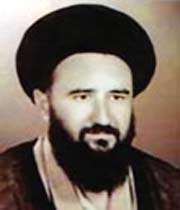Mostafa Khomeini
Sayyid Mostafa Khomeini (12 December 1930 – 23 October 1977) was an Iranian cleric and the son of Ayatollah Khomeini. He died before the 1979 revolution.
Mostafa Khomeini | |
|---|---|
 | |
| Born | 12 December 1930 |
| Died | 23 October 1977 (aged 46) |
| Resting place | Najaf |
| Nationality | Iranian |
| Parent(s) | Ruhollah Khomeini Khadijeh Saqafi |
Early life and education
Khomeini was born in Qom on 12 December 1930.[1] He was the eldest son of Ayatollah Khomeini and Khadijeh Saqafi, daughter of a respected cleric, Hajj Mirza Tehrani.[2]
He graduated from the Qom Theological Center.[1]
Activities
Khomeini participated in his father's movement.[1] He was arrested and imprisoned after the 1963 events and also, after his father's exile.[3] On 3 January 1965, he joined his father in Bursa, Turkey, where he was in exile.[3] Then he lived with his family in Najaf, Iraq.[1] He and his brother Ahmad became part of Khomeini's underground movement in Najaf.[4] The group also included Mohammad Hussein Behesti and Morteza Motahhari.[4]
Death
Khomeini died in Najaf on 23 October 1977.[5] He was buried in Najaf within the shrine of Imam Ali[6] thanks to Musa al-Musawi[7]
His death has been regarded as suspicious by both the followers of Ayatollah Khomeini and common people of Iran due to his death being announced while he was in police custody and various reports that SAVAK agents were present at the scene.[8] Hence, his death was attributed to the Shah's secret police, SAVAK.[5] His father later described Mostafa's death as "martyrdom" and one of the "hidden favours" of God because it fueled the growing discontent with the Shah which finally produced Iranian Revolution just slightly over 1 year after Mostafa's death.[9]
References
- "Biography and Struggles of Ayatollah Sayyid Mustafa Khomeini". Imam Khomeini. Retrieved 9 August 2013.
- H. Dabashi (1993). Theology of discont (PDF). New York: New York University Press. Archived from the original (PDF) on 15 February 2017. Retrieved 9 August 2013.
- Baqer Moin (1999). Khomeini: Life of the Ayatollah. I.B.Tauris. p. 136. ISBN 978-1-85043-128-2. Retrieved 9 August 2013.
- Samii, Abbas William (1997). "The Shah's Lebanon policy: the role of SAVAK". Middle Eastern Studies. 33 (1): 66–91. doi:10.1080/00263209708701142.
- Michael Axworthy (1 September 2013). Revolutionary Iran: A History of the Islamic Republic. Oxford University Press. p. 99. ISBN 978-0-19-932226-8. Retrieved 9 August 2013.
- Ismail Zabeeh (4 January 2007). "Mustafa Khomeini's tomb reopens". Jafariya News. Retrieved 9 August 2013.
- al-Duktūr, Mūsawī, Mūsá (23 January 1987). The miserable revolution. Dar Al-Maʼmun. OL 2104944M.
- Imam Khomeini life, thought and legacy : essays from an Islamic movement perspective. Abdar Rahman Koya. Kuala Lumpur: Islamic Book Trust. 2009. ISBN 9789675062254. OCLC 434746901.CS1 maint: others (link)
- Abdar Rahman Koya (2009). Imam Khomeini: Life, Thought and Legacy. The Other Press. p. 41. ISBN 978-967-5062-25-4. Retrieved 9 August 2013.
External link
![]()
